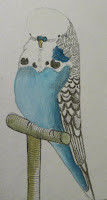Illustrated by Quentin Blake, this book is a personal account of what has happened in the author's (Rosen's) life.
As the title describes, the book is about his sadness which revolves around the loss of his child. It's a short account of why he's sad, what he does when he's sad and how he tries to combat it. Unlike many children's stories, there is no definitive happy ending; the reader just feels a snippet of hope towards the end of the book that everything may be ok in time. I guess doing this gives a much more real approach to subjects such as mourning and depression as a lot of people don't come out of it easily.
This is why I wanted to choose a subject that can help possible readers to cope/understand. When I read the book, I connected to it. It's simple, it's to the point, it's raw. This book is the kind that can help others; they can relate, mourn, and empasise with this character, even if they haven't necessarily gone through the extact same thing.
Some of the illustrations show such sadness that, in a way, I think it is a bit too sad for children who aren't going through sad/bad things themselves. Children usually like to be entertained and read books that are uplifting/colourful; ones that make them happy. This is the opposite.
In the book, there's a lot of grey/muddy brown/creams which helps to create the feeling of sadness, and they're balanced out by the colourful images which mostly depict scenes that remind Rosen of happiness. I do feel like bright colours (greens, reds etc) should only have been used on the happier, reminiscing pages, as this would have reinforced the differences between the two emotions. But doing this, would mean a lot of the book would be grey/brown/dark. I am assuming this book was aimed for children, and if Blake did this, then it would have been too dull.
The use of colour is something that I need to look at when I have completed my storyboard.
It helps to reflect the mood of the narrative
Helps to tell the story.
Ant Jumratsilpa
http://antsj.wordpress.com/category/briefs/




















